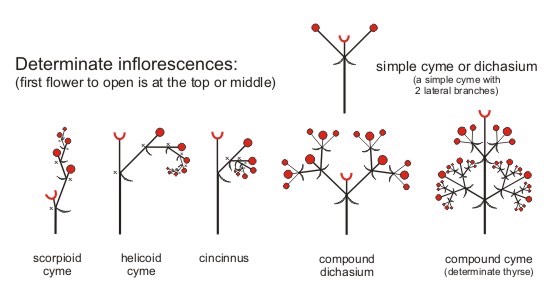

Attributes: Genus: Helleborus Species: foetidus Family: Ranunculaceae Life Cycle: Perennial Recommended Propagation Strategy: Seed Country Or Region Of Origin: mountainous regions of Europe, Greece and Asia Minor Particularly Resistant To (Insects/Diseases/Other Problems): Deer Dimensions: Height: 1 ft.Tags: #evergreen #showy flowers #poisonous #perennials #yellow-green #green flowers #shade garden #broadleaf evergreen #low maintenance #winter interest #cpp #spreading #long-lasting flowers #deer resistant #cream flowers #naturalizes #self-seeding #clumping #fantz #flowers early spring #malodorous #partial shade tolerant #HS302 #heavy shade tolerant #woodland garden See this plant in the following landscapes: Shaded Slope Wild Side- A Shady Garden Shaded Slope Hydrangeas in the Garden Cultivars / Varieties:
Cyme or panicle full#
Prefers partial to full shade prefers organic-enriched soil intolerant of bright winter sun and high temperatures Fungal diseases are the main problem.
Flower center of numerous stamens outlined by tubular nectaries, or fleshy, beaked capsulesīlooms in late winter to very early spring utilized for borders or patios in protected, shady spots poisonous leaves and roots- Greek 'helein'= to injure and 'bora'= food excellent for long, winter blooming display. Leaves are palmately divided into many leaflets. Short plant with stiff, large, evergreen leaves. The leaves, when crushed or bruised, give off a smell that many describe as unpleasant or strange. Although 'foetidus' means fetid, or smelly, the plant as a whole is not unpleasant smelling. It blooms in late winter to early spring, with unusual yellow-green pendant, cup-shaped blossoms with a maroon rim that are surrounded by pale green bracts. Helleborus foetidus is an interesting plant to grow in a shady garden. flowers bisexual.Phonetic Spelling hel-eh-BORE-us FOY-tih-dus This plant has medium severity poison characteristics. 6.ġ4.the ancestral inflorescence of the genus tulipa is supposed to be more primitive drepanium than raceme which is deprived from Cyme.ġ5.inflorescence a corymbose Cyme, leaf-opposed or pseudo terminal, often at tips of tendrils.ġ6.inflorescence terminal, a corymbose Cyme or panicle. the dichasial Cyme) is one in which the progression of flower opening is from the center to the periphery.Ĩ.inflorescence a leaf-opposed glomerule or Cyme.ĩ.herbs, without latex inflorescences a lax Cyme.ġ0.disk well developed, 5-lobed inflorescence a corymbose Cyme, reduced inflorescence often appearing at tip of tendrils.ġ1.with an increase in n fertilizer application, n absorption and content in the plants, and stem flowering percentage and number of florets per Cyme significantly increased.ġ2.the new species is similar to chirita eburnea hance in its habit and leaf form, but differs by its nutant Cyme, flavous corolla, anthers and staminodes white lanate at apex.ġ3.in celastraceae, the evolution of inflorescence might show the following trend: dichasial Cyme was the most fundamental inflorescence type, and the other inflorescence types could be evolved from it. distinguish the true from the false and determination of the contents for fruit juiceħ.centrifugal xylem differentiates from the center outwards, and a centrifugal inflorescence ( e.g. 
Ħ.this special small true fruit induced by duplicata phenomenon is an interim type of inflorescence between the monochasium and raceme cup shaped Cyme.

seeds spheroid hilum elliptic at back, surface with netlike ornamentations. inflorescences a fascicle or Cyme.ģ.inflorescence a flat-topped Cyme, axillary, few-flowered.Ĥ.flowers solitary, several in a loose Cyme, or numerous and clustered into capitula, subtended by 1-4 pairs of appressed bracts.ĥ.tendrils palmately branched. 1.umbrella room type Cyme, axil is born or the top is born, scattered, slue is spent.Ģ.veins pinnate.







 0 kommentar(er)
0 kommentar(er)
